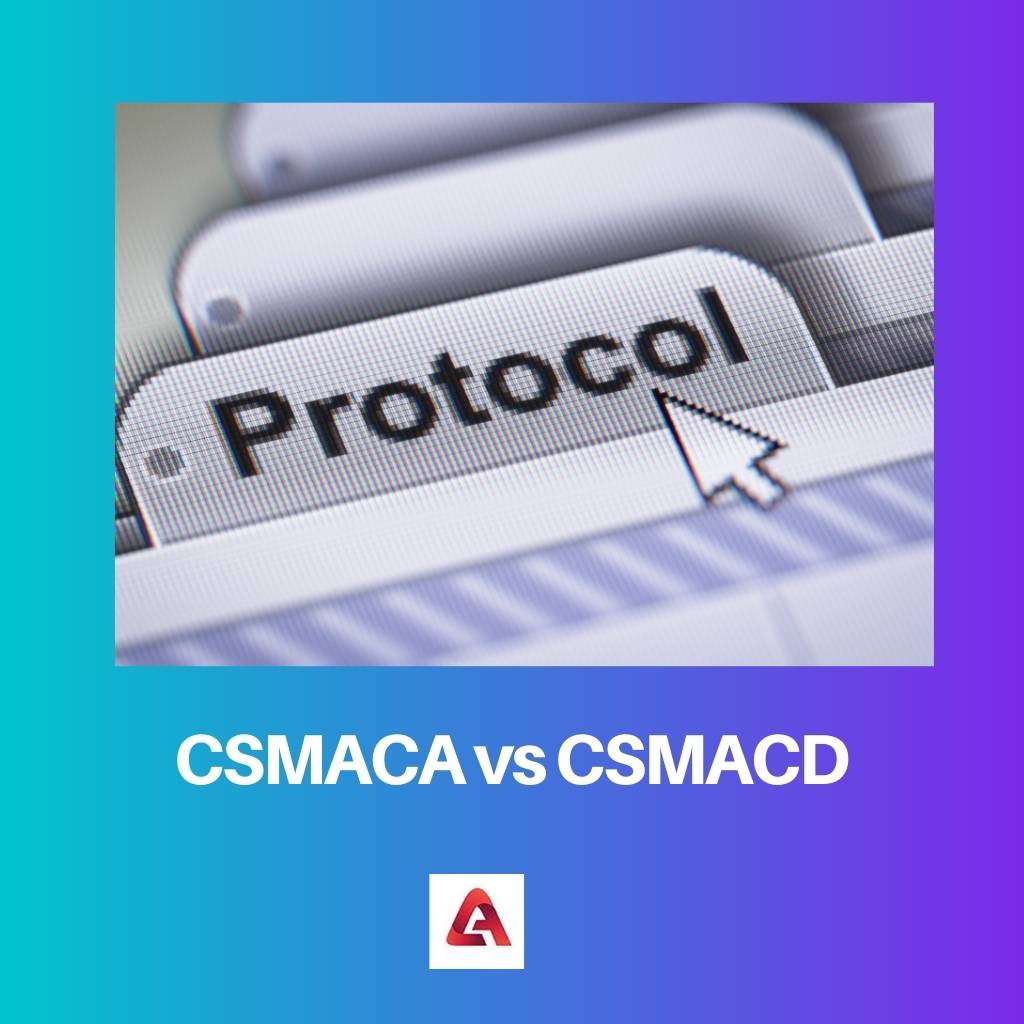Collision avoidance and Collision-detection are two types of CSMA: Carrier-sense multiple access and a Media Access Protocol (MAC).
Here, a node needs to confirm whether there is any kind of traffic on the shared transmission channel. Though they are very similar kinds of terms, there are few notable differences between them when observed closely.
Key Takeaways
- CSMA/CA (Collision Avoidance) is used in wireless networks, while CSMA/CD (Collision Detection) is used in wired networks.
- CSMA/CA involves a request to send and clear to send mechanism, while CSMA/CD involves a carrier sense mechanism.
- CSMA/CA avoids collisions by waiting for a clear channel, while CSMA/CD detects collisions and retries transmission after a random delay.
CSMACA vs CSMACD
CSMA/CA (Carrier Sense Multiple Access with Collision Avoidance) is a network protocol, and it is used predominantly in Wi-Fi networks to avoid collisions before they happen. CSMA/CD (Carrier Sense Multiple Access with Collision Detection) is a network protocol that is used primarily in wired networks, it detects collisions after they occur and then takes corrective action.

Carrier Sense Multiple Access / Collision Avoidance, or CSMA/CA, is a part of CSMA, which is a carrier transmission network protocol. It operates in the same media access control layer as CSMA/CD, and in the 802.11 standards, CSMA / CA is employed.
Unlike CSMA/CD, which only works after a collision, CSMA/CA works before a collision.
Carrier Sense Multiple Access / Collision Detection (CSMA/CD) is a network protocol for carrier transfer that stands for Carrier Sense Multiple Access / Collision Detection.
It detects that the shared channel for broadcasting is busy and interrupts the broadcast till the channel becomes available. CSMA/CD outperforms CSMA in terms of efficiency.
Comparison Table
| Parameters of Comparison | CSMACA | CSMACD |
|---|---|---|
| Used When | Before a collision, CSMA/CA is employed. | Unlike CSMA/CA, following a collision, CSMA/CD is useful. |
| Network Type | In wireless networks, CSMA/CA is commonly utilized. | In wired networks, CSMA/CD is employed. |
| Time for Recovery | A collision is less likely as a result of the protocol. | Recovery time is cut in half with CSMA/CD. |
| Conflict Management | Transmits the intent to deliver the data first. The data is sent after receiving an acknowledgment. | If there is a dispute during transmission, CSMA/CD will resend the data frame. |
| Efficacy | When it comes to efficiency, CSMA/CD trumps CSMA. | In comparison to CSMA, CSMA/CD is more efficient. |
What is CSMACA?
In computer networking, carrier-sense multiple access with collision avoidance (CSMA/CA) is a network multiple access approach in which nodes use carrier sensing but only transmit when the channel is sensed to be “idle.”
It’s especially crucial for wireless networks because the alternative CSMA/CD can’t detect collisions. After all, wireless transmitters desensitize their receivers during packet transmission.
Because of the hidden node problem, CSMA/CA is unreliable. The Data Link Layer (Layer 2) of the OSI model is where the CSMA/CA protocol functions. It operates in the same media access control layer as CSMA/CD, and in the 802.11 standards, CSMA / CA is employed.
Collision Avoidance acts as a network traffic controller for devices, preventing problems from arising.
Although CSMA/CA has been utilized in several wired communication systems, it is especially useful in a wireless LAN since it solves the problem of many stations seeing the Access Point but not each other. CSMA/CA transmits the intent to deliver the data first.
The sender then sends the data after receiving an acknowledgement.
The modulation technique used to transport data between nodes is significantly responsible for CSMA/CA performance. CSMA/CA also finds its usage in bus networks. In wireless networks, CSMA/CA is more commonly utilized.
What is CSMACD?
CSMA/CD, which is carrier-sense multiple access with collision detection, is a type of CSMA that is Carrier-sense multiple access which comes under the media access control (MAC) mechanism that was first utilized for local area networking in early Ethernet technology.
This is used in conjunction with collision detection, which involves a transmitting station monitoring signals from other stations to detect collisions.
This is used in conjunction with collision detection, which involves a transmitting station monitoring transmissions from other stations while transmitting a frame.
The channel capture effect was originally seen in Ethernet networks utilizing CSMA/CD.
In its most basic form, Collision Detection recognizes problems after they have occurred, then attempts to clean up and try again. CSMA/CD will resend the data frame if there is a dispute during transmission.
CSMA/CD outperforms CSMA in terms of efficiency. CSMA / CD is utilized in the 802.3 standards.
Any half-duplex link employs CSMA/CD. Short answer: The support is still available, but it’s mostly used when legacy equipment is connected, such as hubs or very old (or embedded) network interfaces that only allow 10Mbps and don’t support auto-negotiation.
In wired networks, CSMA/CD is employed. Recovery time is cut in half with CSMA/CD.
Main Differences Between CSMACA and CSMACD
- CSMA/CA is employed before the occurrence of a collision, and following a collision, CSMA/CD is useful. Collision detection, in its most basic form, detects problems after they have occurred and seeks to clear them up before trying again. Collision Avoidance acts as a network traffic controller for devices, preventing problems from arising.
- In wireless networks, CSMA/CA is commonly utilized, whereas in wired networks, CSMA/CD is employed.
- The CSMA/CA protocol reduces the likelihood of a collision. CSMA/CD, on the other hand, cuts recuperation time in half.
- CSMA/CA transmits the intent to deliver the data first. The sender then sends the data after receiving an acknowledgement. Whereas, if there is a dispute during transmission, CSMA/CD will resend the data frame.
- In terms of efficiency, CSMA/CA is comparable to CSMA, while CSMA/CD is even more efficient than that.




